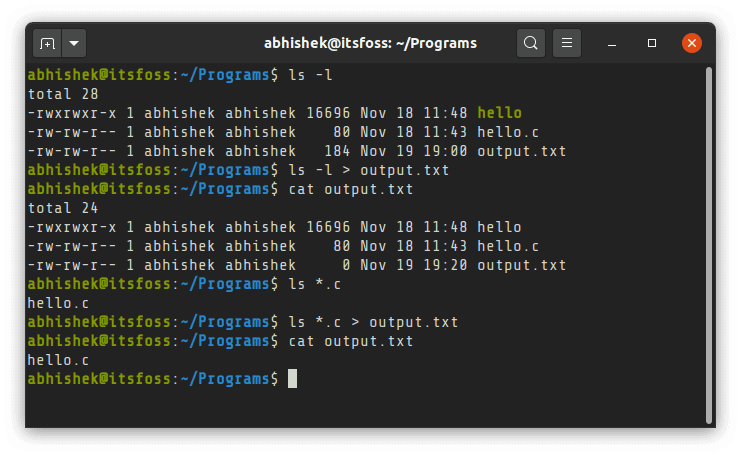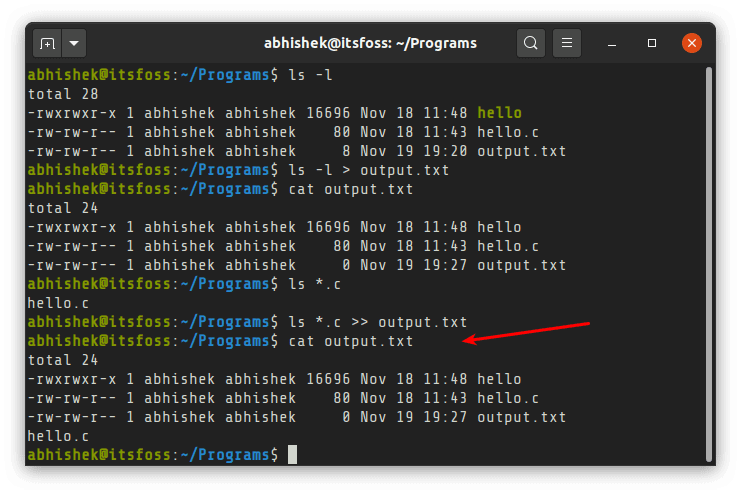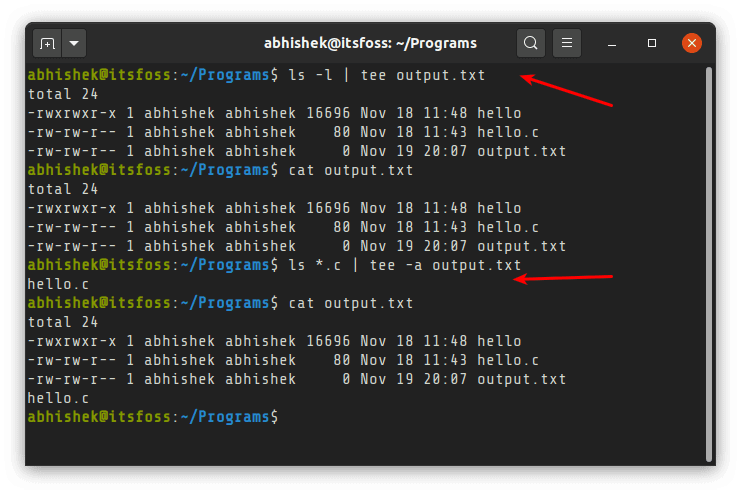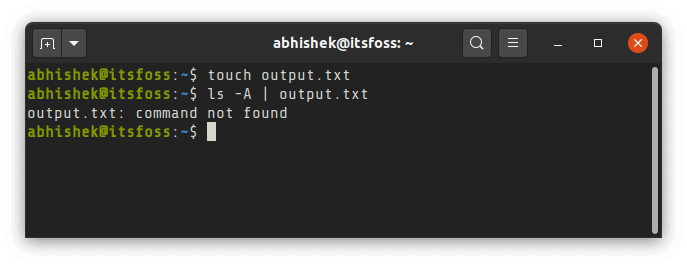- How do I save terminal output to a file?
- 10 Answers 10
- Overview:
- List:
- How to Save the Output of a Command to a File in Linux Terminal
- Method 1: Use redirection to save command output to file in Linux
- Bonus Tip: Save Linux command output as well as error to a file
- Method 2: Use tee command to display the output and save it to a file as well
- Note: Avoid pipe pitfall while saving command output to a file
- Is there a way to save a command in Ubuntu terminal if I haven’t entered it?
- 10 Answers 10
- How to Save Command Output to a File in Linux
- Method 1: Using the “>” Operator
- Method 2: Using the “>>” Operator
- Method 3: Using the “tee” Command
- Conclusion
How do I save terminal output to a file?
How do I save the output of a command to a file? Is there a way without using any software? I would like to know how.
10 Answers 10
Yes it is possible, just redirect the output (AKA stdout ) to a file:
Or if you want to append data:
If you want stderr as well use this:
if you want to have both stderr and output displayed on the console and in a file use this:
SomeCommand 2>&1 | tee SomeFile.txt (If you want the output only, drop the 2 above)
Note that someCommand 2> someFile.txt and someCommand 2>> someFile.txt also redirects stterr to someFile.txt
I’m trying to do this with gcc command but it doesn’t work. It works with other commands, but not this one. It simply creates the output file with nothing inside it.
@Nik-Lz Often this is because the command is sending all its output on stderr. If gcc is generating error messages, this seems likely. See Slothworks comment for how to capture stderr instead of stdout.
NB: to get the output of the make command into a file it requires this syntax instead: make > someFile.txt 2>&1 (source: linuxquestions.org/questions/linux-newbie-8/…)
To write the output of a command to a file, there are basically 10 commonly used ways.
Overview:
Please note that the n.e. in the syntax column means «not existing».
There is a way, but it’s too complicated to fit into the column. You can find a helpful link in the List section about it.
|| visible in terminal || visible in file || existing Syntax || StdOut | StdErr || StdOut | StdErr || file ==========++==========+==========++==========+==========++=========== > || no | yes || yes | no || overwrite >> || no | yes || yes | no || append || | || | || 2> || yes | no || no | yes || overwrite 2>> || yes | no || no | yes || append || | || | || &> || no | no || yes | yes || overwrite &>> || no | no || yes | yes || append || | || | || | tee || yes | yes || yes | no || overwrite | tee -a || yes | yes || yes | no || append || | || | || n.e. (*) || yes | yes || no | yes || overwrite n.e. (*) || yes | yes || no | yes || append || | || | || |& tee || yes | yes || yes | yes || overwrite |& tee -a || yes | yes || yes | yes || append List:
- command > output.txt The standard output stream will be redirected to the file only, it will not be visible in the terminal. If the file already exists, it gets overwritten.
- command >> output.txt The standard output stream will be redirected to the file only, it will not be visible in the terminal. If the file already exists, the new data will get appended to the end of the file.
- command 2> output.txt The standard error stream will be redirected to the file only, it will not be visible in the terminal. If the file already exists, it gets overwritten.
- command 2>> output.txt The standard error stream will be redirected to the file only, it will not be visible in the terminal. If the file already exists, the new data will get appended to the end of the file.
- command &> output.txt Both the standard output and standard error stream will be redirected to the file only, nothing will be visible in the terminal. If the file already exists, it gets overwritten.
- command &>> output.txt Both the standard output and standard error stream will be redirected to the file only, nothing will be visible in the terminal. If the file already exists, the new data will get appended to the end of the file..
- command | tee output.txt The standard output stream will be copied to the file, it will still be visible in the terminal. If the file already exists, it gets overwritten.
- command | tee -a output.txt The standard output stream will be copied to the file, it will still be visible in the terminal. If the file already exists, the new data will get appended to the end of the file.
- (*) Bash has no shorthand syntax that allows piping only StdErr to a second command, which would be needed here in combination with tee again to complete the table. If you really need something like that, please look at «How to pipe stderr, and not stdout?» on Stack Overflow for some ways how this can be done e.g. by swapping streams or using process substitution.
- command |& tee output.txt Both the standard output and standard error streams will be copied to the file while still being visible in the terminal. If the file already exists, it gets overwritten.
- command |& tee -a output.txt Both the standard output and standard error streams will be copied to the file while still being visible in the terminal. If the file already exists, the new data will get appended to the end of the file.
How to Save the Output of a Command to a File in Linux Terminal
When you run a command or script in the Linux terminal, it prints the output on the screen for your immediate viewing. What if you want to save it to a file?
When you run a command or script in the Linux terminal, it prints the output on the screen for your immediate viewing. There will be times when you need to save the output to a file for future references. Now, you can surely copy and paste in Linux terminal but there are better ways to save the output of a shell script or command in Linux command line. Let me show them to you.
Method 1: Use redirection to save command output to file in Linux
- The > redirects the command output to a file replacing any existing content on the file.
- The >> redirect adds the command output at the end of the file’s existing content (if any).
Use the STDOUT redirection operator > for redirecting the output to a file like this:
If the file.txt doesn’t exist, it will be created automatically. If you use the > redirect again with the same file, the file content is replaced by the new output.
The example below demonstrates it better. It first saves the output of ls -l command. And then later, it replaces the content of the file with the output of ls *.c command.
If you don’t want to lose the content of the existing file while saving the output of a script or command, use the redirection operation in append mode with >>.
This example demonstrates it better:
Even here, if the file doesn’t exist, it is created automatically.
Bonus Tip: Save Linux command output as well as error to a file
If your Linux command returns an error, it doesn’t get saved in the file. You can save both the command output and command error in the same file using 2>&1 like this:
Basically, 0 stands for standard input, 1 for standard output and 2 for standard error.
Here, you are redirecting (>) standard error (2) to the same address (&) as standard output (1).
Method 2: Use tee command to display the output and save it to a file as well
By the way, did you notice that when you send the command output to a file, you cannot see it anymore on the display? The tee command in Linux solves this problem for you.
Like a tee pipe that sends a water stream in two directions, the tee command sends the output to the display as well as to a file (or as input to another command). You can use it like this:
Again, the file will be created automatically if it doesn’t exist already.
You may also use the tee command in append mode with option -a in this manner:
Let me demonstrate it with some easy-to-follow examples:
I have used simple Linux commands in my examples. But rest assured; you can use these methods to save the output of bash scripts as well.
Note: Avoid pipe pitfall while saving command output to a file
You probably are familiar with pipe redirection. You may use it to combine Linux commands but you cannot pipe the output to a file. It will result in an error that filename command not found:
This is because the pipe redirects one command’s output to another command’s input. And in this case, you give it a file name while it is expecting a command.
If you are new to the Linux command line, I hope this quick tutorial added to your Linux knowledge a bit. I/O redirection is an essential concept that one should be aware of.
As always, questions and suggestions are always welcome.
Is there a way to save a command in Ubuntu terminal if I haven’t entered it?
I want to be able to save the command for later use in an easy way that’s not just putting a # before it and putting it in the up and down key history. Optimally saving it directly to a register or the clipboard.
I forgot to mention that I didn’t want to echo, either.
With bash in Ubuntu, I can hit Meta+Enter (=Alt+Enter) which places the # in front of the command and give a newline in one go, without moving the cursor, just a half second faster than POS1 (HOME)-key for movement. Of course, you need to try it out with some simple, harmless commands.
@userunknown The standard shortcut is alt + # which is referred to as the ‘insert-comment’ command in the Bash docs (their notation is M-#). gnu.org/software/bash/manual/bash.html#Command-Line-Editing
10 Answers 10
This is not your terminal, this is your shell.
The name for the shell mechanism that you are looking for is a kill buffer. People forget that shell command line editors have these. ZLE in the Z shell has them, as have GNU Readline in the Bourne Again shell, libedit in the (FreeBSD) Almquist shell, the Korn shell’s line editor, and the TENEX C shell’s line editor.
In all of these shells in emacs mode, simply go to the end of the line to be saved, kill it to the head kill buffer with ⎈ Control + U , type and run the intermediate command, and then yank the kill buffer contents with ⎈ Control + Y . Ensure that you do not do anything with the kill buffer when entering the intermediate command.
In the Z shell in vi mode, you have the vi prefix sequences for specifying a named vi -style buffer to kill the line into. You can use one of the other buffers instead of the default buffer. Simply use something like » a d d (in vicmd mode) to delete the whole line into buffer «a», type and run the intermediate command, and then put that buffer’s contents with » a p .
In their vi modes, the Korn shell, GNU Readline in the Bourne Again shell, and libedit in the (FreeBSD) Almquist shell do not have named vi -style buffers, only the one cut buffer. d d to delete the line into that buffer, followed by putting the buffer contents with p , will work. But it uses the same vi -style buffer that killing and yanking will while entering the intermediate command.
How to Save Command Output to a File in Linux
In Linux, the command line is a powerful tool for interacting with the system. One common task when working with the command line is saving the output of a command to a file for future reference. There are several ways to accomplish this task in Linux, and in this article, we’ll cover some of the most common methods.
Method 1: Using the “>” Operator
The simplest way to save the output of a command to a file is by using the “>” operator. This operator redirects the standard output of a command to a file instead of printing it to the terminal. For example, to save the output of the “ls” command to a file named “file_list.txt”, you can use the following command:
This command will create a file called “file_list.txt” in the current directory and save the output of the “ls” command to that file.
Method 2: Using the “>>” Operator
The “>>” operator works in a similar way to the “>” operator, but instead of overwriting the contents of the file, it appends the output of the command to the end of the file. For example, to append the output of the “date” command to a file called “log.txt”, you can use the following command:
This command will append the current date and time to the end of the “log.txt” file.
Method 3: Using the “tee” Command
The “tee” command is a Linux command that allows you to redirect the output of a command to both the screen and a file. This can be useful if you want to see the output of a command on the screen while also saving it to a file. For example, to save the output of the “df” command to a file called “disk_space.txt” and display it on the screen at the same time, you can use the following command:
This command will display the output of the “df” command on the screen and save it to a file called “disk_space.txt” at the same time.
The above command will overwrite the existing content. You can use -a option with tee command to append the content to file.
df -h | tee -a disk_space.txt Conclusion
Saving command output to a file is a common task in Linux, and there are several ways to accomplish it. Using the “>” and “>>” operators and the “tee” command are some of the most common methods. By mastering these techniques, you can save time and increase your productivity when working with the Linux command line.



